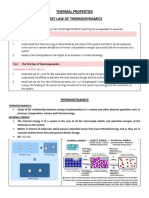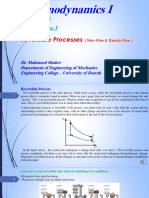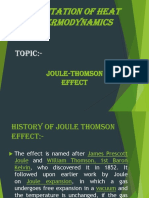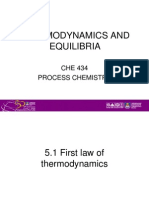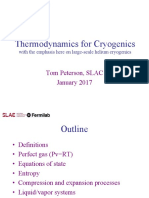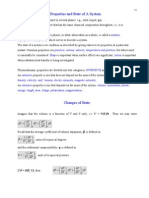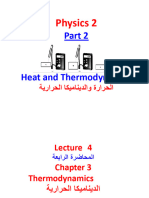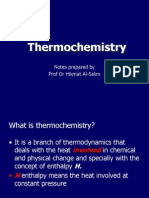Compressibility Factor: RT B V V A P
Compressibility Factor: RT B V V A P
Uploaded by
Abid Al Chem NugamaCopyright:
Available Formats
Compressibility Factor: RT B V V A P
Compressibility Factor: RT B V V A P
Uploaded by
Abid Al Chem NugamaOriginal Description:
Original Title
Copyright
Available Formats
Share this document
Did you find this document useful?
Is this content inappropriate?
Copyright:
Available Formats
Compressibility Factor: RT B V V A P
Compressibility Factor: RT B V V A P
Uploaded by
Abid Al Chem NugamaCopyright:
Available Formats
UGM
Compressibility Factor
Definition
Z= v actual v actual pv actual = = v ideal RT p RT
-AT-
Department of Engineering Physics, Faculty of Engineering, Gadjah Mada University (Study Programs of Engineering Physics & Nuclear Engineering) Jl. Grafika 2, Yogyakarta 55281, (+62 274) 580882, http://www.tf.ugm.ac.id/
Department of Engineering Physics, Faculty of Engineering Study Programs of Engineering Physics & Nuclear Engineering
Joule-Thomson Experiment
a measure of deviation from ideal gas behavior approaches unity at low pressures Z for real gases is correlated in terms of reduced pressure and reduced temperature
2
UGM
Model Gas Real
Perbedaan dengan model gas ideal
o o
UGM
Persamaan van der Waals
Persamaan keadaan dari van der Waals
a p + 2 (v b ) = RT v
Volume molekul memperkecil ruang gerak bebas molekul. Antar molekul terjadi interaksi.
Department of Engineering Physics, Faculty of Engineering Study Programs of Engineering Physics & Nuclear Engineering
Department of Engineering Physics, Faculty of Engineering Study Programs of Engineering Physics & Nuclear Engineering
Salah satu cara untuk modifikasi dari gas ideal adalah dengan menetapkan Faktor gas real.
Z = pv RT
dengan a, b: konstanta karakteristik dari gas
o o
dengan:
Z =1+ B (T ) C (T ) D (T ) + 2 + 3 +L v v v
3
b: Kovolume a: Tekanan kohesi, merupakan koreksi dari penurunan tekanan gas ke dinding akibat adanya gaya interaksi antar molekul.
UGM
Diferensial Total
Difenrensial total dari suatu fungsi f(x,y)
f f df = dx + y dy x y x
UGM
Persamaan Gas
Entalpi:
v dh = c p dT + v T dp T p
Department of Engineering Physics, Faculty of Engineering Study Programs of Engineering Physics & Nuclear Engineering
Department of Engineering Physics, Faculty of Engineering Study Programs of Engineering Physics & Nuclear Engineering
2 f 2 f = x y y x
f f y = y x x y y x x
Energi internal:
p du = c v dT + T p dv T v
UGM
Joule Experiment
Measurement of the change in internal energy when a gas expands isothermally. The heat absorbed by the gas is proportional to the change in temperature of the bath.
lim p 1 0, Tbath = 0 p 1 : pressure of the gas & it expands into the bulb at p 2 = 0 U = q + w w = 0 & q = C V T when a low pressure gas (ideal gas) is expanded it does so without a change in internal energy, U. U U dU = dT + dV T V V T From Joule' s experiment , dU = 0 & dT = 0 U hence = 0 for an ideal gas. V i.e., U = f(T) only for an ideal gas.
T
UGM
Joule Thomson Experiment
The gas expands through the porous barrier, which acts as a throttle, and the whole apparatus is thermally insulated. This arrangement corresponds to an isenthalpic expansion (expansion at constant enthalpy). Whether the expansion results in a heating or a cooling of the gas depends on the conditions.
Department of Engineering Physics, Faculty of Engineering Study Programs of Engineering Physics & Nuclear Engineering
Department of Engineering Physics, Faculty of Engineering Study Programs of Engineering Physics & Nuclear Engineering
UGM
Joule Thomson expansion
The pistons represent the upstream and downstream gases, which maintain constant pressures either side of the throttle. The transition from the top diagram to the bottom diagram, which represents the passage of a given amount of gas through the throttle, occurs without change of enthalpy.
H
UGM
Joule-Thomson Coefficient
H (T , p ) H H dH = dT + p T p for isenthalpi c dp T
For ideal gas, H = f(T) only H p =0 T for real gas H p 0 T
Department of Engineering Physics, Faculty of Engineering Study Programs of Engineering Physics & Nuclear Engineering
Department of Engineering Physics, Faculty of Engineering Study Programs of Engineering Physics & Nuclear Engineering
= U + PV
H 0 = C p dT + p T p
H = U + (PV )
First law of thermodyna mics :
dp T T
H =
w w
+ p 2 V2 p 1V1 = p1dV
V1 0 V2
1 H = C H p p
Qq = 0& H = 0
p 2 dV = p 1V1 p 2 V2 0
(isenthalpi c )
9
T = JT p H
Joule-Thomson Coefficient
10
UGM
Apparatus
Measurement of the isothermal Joule-Thomson coefficient (JT) is given below. The electrical heating required to offset the cooling arising from expansion is interpreted as H and used to calculate (H/p)T, which is then converted to .
UGM
Inversion
The sign of the Joule-Thomson coefficient, , depends on the conditions. Inside the boundary, the shaded area, it is positive and outside it is negative. The temperature corresponding to the boundary at a given pressure is the `inversion temperature' of the gas at that pressure. For a given pressure, the temperature must be below a certain value if cooling is required but, if it becomes too low, the boundary is crossed again and heating occurs. Reduction of pressure under adiabatic conditions moves the system along one of the isenthalps, or curves of constant enthalpy. The inversion temperature curve runs through the points of the isenthalps where their slopes change from negative to positive.
Department of Engineering Physics, Faculty of Engineering Study Programs of Engineering Physics & Nuclear Engineering
Department of Engineering Physics, Faculty of Engineering Study Programs of Engineering Physics & Nuclear Engineering
11
12
UGM
Inversion
The inversion temperatures for three real gases, nitrogen, hydrogen, and helium.
UGM
Pencairan Gas
Penentu aplikasi teknik pencairan gas adalah titik kritis. Gas NH3 dikompresi menjadi 10 bar, didinginkan dengan suhu lingkungan dan diekspansikan.
Department of Engineering Physics, Faculty of Engineering Study Programs of Engineering Physics & Nuclear Engineering
13
Department of Engineering Physics, Faculty of Engineering Study Programs of Engineering Physics & Nuclear Engineering
14
UGM
Udara
Titik kritis pada suhu -147C
UGM
Proses Linde
Secara bertingkat, udara dikompresi isotermal, kemudian didinginkan dengan aliran berlawanan dengan udara lebih dingin yang belum mencair.
Department of Engineering Physics, Faculty of Engineering Study Programs of Engineering Physics & Nuclear Engineering
15
Department of Engineering Physics, Faculty of Engineering Study Programs of Engineering Physics & Nuclear Engineering
16
UGM
Linde refrigerator
The gas is recirculated and, so long as it is below its inversion temperature, it cools on expansion through the throttle. The cooled gas cools the high-pressure gas, which cools still further as it expands. Eventually liquefied gas drips from the throttle.
UGM
Claude liquefaction process
Replace the throttle valve by an expander:
o
Department of Engineering Physics, Faculty of Engineering Study Programs of Engineering Physics & Nuclear Engineering
17
Department of Engineering Physics, Faculty of Engineering Study Programs of Engineering Physics & Nuclear Engineering
Gas expander saturated or slightly superheated vapor cooled and throttled to produce liquefaction (as in the Linde process) unliquefied portion mixes with the expander exhaust and returns for recycle.
18
UGM
Liquefaction processes
Common use for:
o o o
Department of Engineering Physics, Faculty of Engineering Study Programs of Engineering Physics & Nuclear Engineering
o o
Liquid propane as a domestic foil Liquid oxygen in rocket Liquid natural gas for ocean transport Liquid nitrogen for low temperature refrigeration Gas mixture are liquefied for separation By heat exchanger at constant pressure By an expansion process from which work is obtained By a throttling process
Cooled to a temperature in the two-phase region:
o o o
19
You might also like
- Ideal Gas Law and Laws of ThermodynamicsDocument9 pagesIdeal Gas Law and Laws of ThermodynamicsVAN STEVEN SANTOSNo ratings yet
- Termodinamika, Entropy, Dan Energi Dalam 2014Document23 pagesTermodinamika, Entropy, Dan Energi Dalam 2014Deriandra MuhyiddinNo ratings yet
- Thermal Preperties FLTDocument58 pagesThermal Preperties FLTrameesa sufiNo ratings yet
- HMT Notes PDFDocument40 pagesHMT Notes PDFSenthil Kumar Subramanian50% (2)
- Heat and Mass Transfer NotesDocument40 pagesHeat and Mass Transfer NotesRithika M NagendiranNo ratings yet
- Chapter 03 Volumetric Properties of Pure Fluids 4 Slides Per PageDocument8 pagesChapter 03 Volumetric Properties of Pure Fluids 4 Slides Per PageHana Atalia100% (1)
- Thermal Physics Lecture 27Document8 pagesThermal Physics Lecture 27OmegaUserNo ratings yet
- Chapter4-Lecture No.1Document19 pagesChapter4-Lecture No.1Mohammad SaleemNo ratings yet
- Thermochemistry: - Petrucci, Herring Madura and BissonnetteDocument49 pagesThermochemistry: - Petrucci, Herring Madura and BissonnetteYousif Khalid100% (1)
- Presentation of Joule Thomson EffectDocument16 pagesPresentation of Joule Thomson EffectAli Raza100% (6)
- Met Phy Chem LectureDocument50 pagesMet Phy Chem LectureEaster Phoebe Durias PaglinawanNo ratings yet
- Chapter 15 Students PhysicsDocument53 pagesChapter 15 Students PhysicsNur Farizah ZuhaidiNo ratings yet
- Entropy ChangeDocument13 pagesEntropy Changeنبيل محمد عيد ابوميراNo ratings yet
- MCQ _ CH 1Document40 pagesMCQ _ CH 1konouz.osamaNo ratings yet
- Internal Flow: Heat TransferDocument22 pagesInternal Flow: Heat TransferSana Nasser100% (1)
- 5.0 Chemical ThermodynamicsDocument24 pages5.0 Chemical ThermodynamicsIVAN ANDRICH I�IGONo ratings yet
- Specific Heat RatioDocument5 pagesSpecific Heat RatioTj RentoyNo ratings yet
- CHY2018 Unit 7 Lecture. Second and Third Law of ThermodynamicsDocument38 pagesCHY2018 Unit 7 Lecture. Second and Third Law of Thermodynamicskha.thompson79No ratings yet
- Chapter 16Document36 pagesChapter 16Mihael RotarescuNo ratings yet
- Joule Thomson ArticleDocument8 pagesJoule Thomson ArticleFagner Goulart DiasNo ratings yet
- Hukum Pertama TermodinamikaDocument123 pagesHukum Pertama TermodinamikaLia TrisnawatiNo ratings yet
- Refrigeration and CryogenicsDocument55 pagesRefrigeration and Cryogenicsjunhyol100% (1)
- Thermo DynamicsDocument21 pagesThermo DynamicsManas Ranjan JenaNo ratings yet
- Chapter 4 - 1&2 PROCESSS CHEMISTRYDocument62 pagesChapter 4 - 1&2 PROCESSS CHEMISTRYNurakmal SyuhAdaNo ratings yet
- Radial Conduction Lab ReportDocument11 pagesRadial Conduction Lab Reportapi-310519283100% (2)
- Physical Chemistry (Part-2)Document73 pagesPhysical Chemistry (Part-2)RSLNo ratings yet
- Heat and Mass Transfer NotesDocument40 pagesHeat and Mass Transfer NotesSanwar TagraNo ratings yet
- Heat and Thermodynamics: 1. Expansion of Solids: A) Coefficient of Linear ExpansionDocument3 pagesHeat and Thermodynamics: 1. Expansion of Solids: A) Coefficient of Linear Expansionmukesh3021No ratings yet
- Thermo - First Second LawDocument35 pagesThermo - First Second LawPengintaiNo ratings yet
- 978 981 15 5753 8 - 50Document15 pages978 981 15 5753 8 - 50Chukwumaobi OluahNo ratings yet
- Advanced Thermodynamics: Volumetric Properties of Pure FluidsDocument36 pagesAdvanced Thermodynamics: Volumetric Properties of Pure FluidsArunodhayam NatarajanNo ratings yet
- Thermodynamics Assignment PresentationDocument21 pagesThermodynamics Assignment Presentationpericharla ravivarmaNo ratings yet
- Natural and Forced Convection ExperimentsDocument12 pagesNatural and Forced Convection ExperimentsOmar Yamil Sanchez Torres25% (4)
- Lecture 10 - Work Heat EnergyDocument8 pagesLecture 10 - Work Heat EnergySYZCNo ratings yet
- Joule Thomson Effect: Paper: Physical Chemistry (UNIT-I Thermodynamics)Document10 pagesJoule Thomson Effect: Paper: Physical Chemistry (UNIT-I Thermodynamics)Shahzad100% (1)
- CML100 Ar2a PDFDocument34 pagesCML100 Ar2a PDFDivyansh GuptaNo ratings yet
- Classical Thermodynamics Statistical Thermodynamics ThermodynamicsDocument68 pagesClassical Thermodynamics Statistical Thermodynamics ThermodynamicsBalakrishna AvaruNo ratings yet
- Lecture 5Document54 pagesLecture 5abode-m-rNo ratings yet
- ME2121-ME1121E Slides (Chapter 2 2014) (Compatibility Mode)Document21 pagesME2121-ME1121E Slides (Chapter 2 2014) (Compatibility Mode)Chad FreemanNo ratings yet
- ThermoDocument15 pagesThermovanitapanda14959No ratings yet
- Lecture 8 - 1st Law of Thermodyanmics - Joule Thomson Effect Updated 04-30-2020Document48 pagesLecture 8 - 1st Law of Thermodyanmics - Joule Thomson Effect Updated 04-30-2020Vicente JonathanNo ratings yet
- (10!4!3) NPTEL - Gas Liquefaction and Refrigeration SystemsDocument46 pages(10!4!3) NPTEL - Gas Liquefaction and Refrigeration SystemsWarren RiveraNo ratings yet
- 5-Thermodynamics For CryogenicsDocument52 pages5-Thermodynamics For CryogenicsBhuvanaNo ratings yet
- Discussion Joule ThomsonDocument3 pagesDiscussion Joule ThomsonKhairul HaqeemNo ratings yet
- Properties and State of A System.: Pressure, Volume, Velocity, Temperature and PositionDocument19 pagesProperties and State of A System.: Pressure, Volume, Velocity, Temperature and PositionbenhasherNo ratings yet
- Plant Engineering 2 - Compressors 1 The Perfect Gas ModelDocument12 pagesPlant Engineering 2 - Compressors 1 The Perfect Gas ModelDee RajanNo ratings yet
- فيزياء 2 - الاسبوع الرابعDocument17 pagesفيزياء 2 - الاسبوع الرابعyousefahmedaNo ratings yet
- Joule-Thomson EffectDocument15 pagesJoule-Thomson EffectTurab GhummanNo ratings yet
- Liquefaction of GasesDocument10 pagesLiquefaction of Gaseskunni590% (1)
- Lecture 5 PDFDocument48 pagesLecture 5 PDFAman tomarNo ratings yet
- Review FinalDocument36 pagesReview Finalnguyenbaotran241104No ratings yet
- Second+law+of+thermodynamics 5+-12+augDocument38 pagesSecond+law+of+thermodynamics 5+-12+augmpumelaqqNo ratings yet
- ThermochemistryDocument50 pagesThermochemistrythobyy100% (4)
- “Foundations to Flight: Mastering Physics from Curiosity to Confidence: Cipher 4”: “Foundations to Flight: Mastering Physics from Curiosity to Confidence, #4From Everand“Foundations to Flight: Mastering Physics from Curiosity to Confidence: Cipher 4”: “Foundations to Flight: Mastering Physics from Curiosity to Confidence, #4Rating: 5 out of 5 stars5/5 (1)
- Treatise on Irreversible and Statistical Thermodynamics: An Introduction to Nonclassical ThermodynamicsFrom EverandTreatise on Irreversible and Statistical Thermodynamics: An Introduction to Nonclassical ThermodynamicsRating: 1 out of 5 stars1/5 (1)
- 09.operational ManualDocument34 pages09.operational ManualMark Allen DejesaNo ratings yet
- Rotation-Vibration Spectroscopy of Carbon Monoxide PurposeDocument6 pagesRotation-Vibration Spectroscopy of Carbon Monoxide PurposeArishNo ratings yet
- Danfoss DML Filter DriersDocument16 pagesDanfoss DML Filter DrierswidhiantoNo ratings yet
- Van Der Waals Heterostructures Nature12385Document7 pagesVan Der Waals Heterostructures Nature12385Luiz IriasNo ratings yet
- Chapter 2 Pure SubstanceDocument52 pagesChapter 2 Pure SubstanceSyafiq AimanNo ratings yet
- Bio IA TaskDocument12 pagesBio IA TaskWen Wen Teh100% (2)
- Solution, Solubility & Gas LawsDocument5 pagesSolution, Solubility & Gas LawsSabbir HossainNo ratings yet
- PaschenDocument11 pagesPaschenSylab InstrumentsNo ratings yet
- SCH 102: Organic Chemistry IDocument152 pagesSCH 102: Organic Chemistry IH to O ChemistryNo ratings yet
- Removal of Water From Industrial Ammonia Systems PDFDocument10 pagesRemoval of Water From Industrial Ammonia Systems PDFMTOLNo ratings yet
- Problems On Fluid PropertiesDocument1 pageProblems On Fluid Propertieshibarik_475% (4)
- The Nature of Opal I. Nomenclature and Constituent PhasesDocument14 pagesThe Nature of Opal I. Nomenclature and Constituent PhasesBbjoy KaZaNo ratings yet
- Test Data 808nm, Conduction-Cooled Diode Laser Single BarDocument7 pagesTest Data 808nm, Conduction-Cooled Diode Laser Single BarUmar BadshahNo ratings yet
- Apreo Trinity Detection System Materials Science White Paper Wp0014Document6 pagesApreo Trinity Detection System Materials Science White Paper Wp0014Yu Shu HearnNo ratings yet
- Heat CalcultionDocument4 pagesHeat CalcultionDgk RajuNo ratings yet
- NRSL GasLawsDocument48 pagesNRSL GasLawsBrenda Aquino100% (1)
- Chapterwise Notes QNA Icse 9 Physics ICSE PDFDocument25 pagesChapterwise Notes QNA Icse 9 Physics ICSE PDFisequaltoklasses.navneetNo ratings yet
- Miscon ElementsDocument16 pagesMiscon Elementsapi-400692183No ratings yet
- Electro-Thermal Modelling of Anode and Cathode in micro-EDMDocument9 pagesElectro-Thermal Modelling of Anode and Cathode in micro-EDMZoltan KantorNo ratings yet
- MCQ For Practice in LectureDocument6 pagesMCQ For Practice in LectureVikas MishraNo ratings yet
- Electronic Structure Calculations of Ammonia Adsorption On Graphene and Graphene Oxide With Epoxide and Hydroxyl GroupsDocument15 pagesElectronic Structure Calculations of Ammonia Adsorption On Graphene and Graphene Oxide With Epoxide and Hydroxyl GroupsRaghav AgarwalNo ratings yet
- AiisDocument17 pagesAiisayushNo ratings yet
- V Sem Heat Transfer Lab ManualDocument4 pagesV Sem Heat Transfer Lab ManualoctoviancletusNo ratings yet
- Role of The Sun PowerpointDocument21 pagesRole of The Sun PowerpointJulie Ann Sanchez100% (1)
- Biomedical Instrumentation I: Lecture-5: The Origin of BiopotentialsDocument35 pagesBiomedical Instrumentation I: Lecture-5: The Origin of BiopotentialsNitin PrajapatiNo ratings yet
- Ncert Exemplar ChemistryDocument22 pagesNcert Exemplar Chemistrysheetal10swetaNo ratings yet
- Ion Implantation DiffusionDocument10 pagesIon Implantation DiffusionshruthidhanNo ratings yet
- CHM 3402 Experment 3Document9 pagesCHM 3402 Experment 3Luqman HakimNo ratings yet
- 1b2 - Cahill Et Al - Common Root Causes For Anode ProblemsDocument20 pages1b2 - Cahill Et Al - Common Root Causes For Anode ProblemsAnne100% (1)
- What Is The Joule-Thomson Effect?Document10 pagesWhat Is The Joule-Thomson Effect?Vivi OktaviantiNo ratings yet



